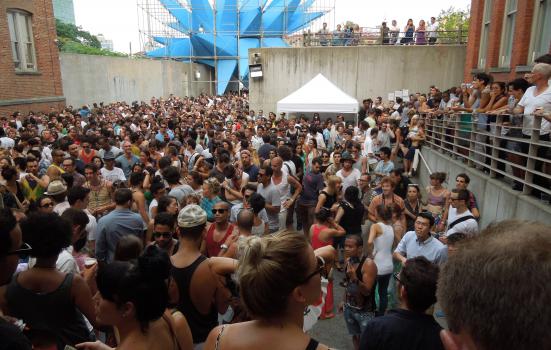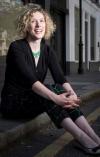Oonagh Murphy’s research into how museums are engaging digitally with their audiences took her to New York. Here she reports on what she saw.

A Winston Churchill Memorial Trust Travel fellowship provided me with the opportunity to research how top New York museums, such as The Met, MoMA and Guggenheim, are using digital technologies to engage with audiences in these challenging times. The aim of the trip was to identify transferable practices that could help shape emerging museum practice in Northern Ireland. Through my research I had become increasingly interested in how small museums are tackling the dilemma of responding to audiences who no longer want to solely read and listen, but influenced by an increasingly social web 2.0 world, want to participate, challenge, engage and enter into a conversation during their visit.
While in New York I visited nearly 30 cultural institutions and interviewed a range of staff from directors of digital departments to those working in education and staff development. From these interviews I discovered that the museums that really understand digital culture are those that are not simply developing projects for today, but are also researching and developing how to use emerging technologies in the future, both short and long term. The key to success it seems is an organisational culture that values and recognises the solid foundations of the past, the successes of the present and possibilities that the future offers.
Digital engagement should be about adding a layer of context
After examining approaches to digital engagement across a broad spectrum of museums in New York I identified four key digital engagement trends:
• Embracing contemporary culture to develop new audiences: Collections provide us with a unique link to the past, but to be interesting to the average visitor, they must also provide a link to the present. Visitors want to know how a museum and its collection are relevant to them today.
• A place for experimentation and innovation by visitors: New technologies are beginning to shift the way visitors are learning. A new model of collaborative learning is beginning to emerge. While museum educators continue to teach visitors about the museum’s collection, increasingly museum visitors themselves are providing museums with new ways to view their collections.
• Peer learning, collaboration and networking: Agile thinking and practices are somewhat at odds with museum culture, as they have a reputation for being slow, often bureaucratic institutions. I was excited to see a range of digital education, marketing, collections and web teams tackle this legacy of bureaucracy by forming their own informal professional skill-sharing networks. These networks can be divided into three categories: informal events, conferences and social networks.
• The museum as an innovative, agile, mission-led institution: It was clear that museums in New York are investing in the future. The old argument “If we put everything online people won’t visit” has been blown out of the water and many museums in New York now recognise that to succeed now and in the future they must develop a culture of research and development that responds to, challenges and works with contemporary and technological advancements.
Indeed, many of the successful projects I witnessed were not ‘digital’ projects per se, but were digitally mediated solutions that were developed in response to real issues faced by real museums. Some projects increased access to collections, others provided new ways to learn in a gallery and online or helped museums build relationships with new audiences. The case studies below show what is possible by any museum or cultural organisation given the right strategic leadership.
It was interesting to see how museums in New York are beginning to recognise that throwing money at singular digital projects is not enough. Instead, a number of key museums, such as The Met, Cooper-Hewitt, New York Public Library and MoMA, have begun to see digital technologies, research and development as a key strategic priority and as such are creating entire departments staffed with people from a range of backgrounds and skill sets to work across the museum. This strategic approach of creating departments, tasked with R&D, emerging technologies and creating sustainable practices, demonstrates an interesting human-resource approach to joined-up thinking that will allow museums to use their historical and contemporary collections in a way that is relevant and engaging to visitors both today and tomorrow.
Digital engagement should be about adding a layer of context, about providing visitors with the opportunity to choose how they want to engage with a museum, be that for entertainment or education. Digital technology provides museums with the opportunity to develop and create an engaged visitor base, one that acknowledges that their local museum is a unique, valuable and relevant cultural institution. Perhaps the most significant thing that I learnt during my time in New York is that strategy and vision are as important if not more so than the resources that are available.
New York Public Library Labs
‘What’s on the Menu?’ is a project that seeks to link the libraries’ collection with the growing trend of food blogging, be that written blogs or people taking photos of food and placing it on Facebook or Instagram. The project invites members of the public to use the library’s collection of historic menus for inspiration, but it also asks online visitors to help the library tag the menus so that the collection will become fully searchable. This is an example of a conservative, historic organisation engaging with digital culture trends to develop new audiences, to demonstrate the value and usefulness of its collection, but also to generate important Meta data through the transcription of menus.
Newark Museum
Newark Museum has created a ‘Makerspace’ in one if its classrooms. It contains cutting-edge technology, such as 3D printers, and is used as a design hub for school groups. In the first Makerspace programme a group of children from a local school visited the museum twice a week over the course of a term. They developed their own computer games inspired by the museum’s collection, and using a 3D printer, printed controllers and through basic electronics they created functioning buttons to play their game. In this ground-breaking programme both the museum and the students involved had a steep learning curve, as together they tested out what was possible with the time and technology available. To fill a skills gap the museum brought in a freelance teacher, but they are now looking to train up their own Makerspace facilitators. Staff reported a strong relationship with students, and the museum now hopes to build on this to encourage these students to continue to visit, and use the museum’s collection to inspire them to develop their new skills.
MoMA PS1
‘Warm Up’ is a series of outdoor music events held every Saturday in July and August, which has been running for 15 years and is a key fundraiser for MoMA PS1. More than simply a big party that happens in the museum courtyard, it helps the museum to fulfil its institutional mission, the events drive social media buzz, prompt online engagement and encourage repeat visits. This is a great example of a project that is not digital in itself but the social nature of the events drives digital engagement and thus the events have a secondary online audience. Visitors have an extended interaction as after they leave many use Facebook and Twitter to post and look at photos and discussions. The social media buzz this event generates is unique, and for MoMA it is priceless.
For more case studies and resources go to http://www.wcmt.org.uk/reports/1065_1.pdf
Oonagh Murphy is a PhD researcher at the Centre for Media Research and The Arts and Humanities Research Institute at the University of Ulster.




